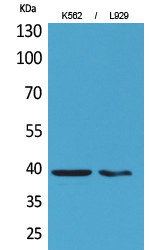CD84 Polyclonal Antibody
- Catalog No.:YT5256
- Applications:WB;IHC;IF;ELISA
- Reactivity:Human;Mouse
- Target:
- CD84
- Gene Name:
- CD84
- Protein Name:
- SLAM family member 5
- Human Gene Id:
- 8832
- Human Swiss Prot No:
- Q9UIB8
- Mouse Gene Id:
- 12523
- Mouse Swiss Prot No:
- Q18PI6
- Immunogen:
- The antiserum was produced against synthesized peptide derived from the Internal region of human CD84. AA range:131-180
- Specificity:
- CD84 Polyclonal Antibody detects endogenous levels of CD84 protein.
- Formulation:
- Liquid in PBS containing 50% glycerol, 0.5% BSA and 0.02% sodium azide.
- Source:
- Polyclonal, Rabbit,IgG
- Dilution:
- WB 1:500 - 1:2000. IHC: 1:100-300 ELISA: 1:20000.. IF 1:50-200
- Purification:
- The antibody was affinity-purified from rabbit antiserum by affinity-chromatography using epitope-specific immunogen.
- Concentration:
- 1 mg/ml
- Storage Stability:
- -15°C to -25°C/1 year(Do not lower than -25°C)
- Other Name:
- CD84;SLAMF5;SLAM family member 5;Cell surface antigen MAX.3;Hly9-beta;Leukocyte differentiation antigen CD84;Signaling lymphocytic activation molecule 5;CD84
- Observed Band(KD):
- 39kD
- Background:
- This gene encodes a membrane glycoprotein that is a member of the signaling lymphocyte activation molecule (SLAM) family. This family forms a subset of the larger CD2 cell-surface receptor Ig superfamily. The encoded protein is a homophilic adhesion molecule that is expressed in numerous immune cells types and is involved in regulating receptor-mediated signaling in those cells. Alternate splicing results in multiple transcript variants. [provided by RefSeq, Oct 2011],
- Function:
- developmental stage:Expression is slightly increased in naive B-cells after the first dividion. By contrast, expression on memory B-cells decreased with each successive division.,domain:ITSM (immunoreceptor tyrosine-based switch motif) motif is a cytoplasmic motif which may bind SH2D1A.,function:Plays a role as adhesion receptor functioning by homophilic interactions and by clustering. Recruits SH2 domain-containing proteins SH2D1A/SAP. Increases proliferative responses of activated T-cells and SH2D1A/SAP does not seen be required for this process. Homophilic interactions enhance interferon gamma/IFNG secretion in lymphocytes and induce platelet stimulation via a SH2D1A/SAP-dependent pathway. May serve as a marker for hematopoietic progenitor cells.,PTM:N-glycosylated.,PTM:Phosphorylated by tyrosine-protein kinase LCK on tyrosine residues following ligation induced by agonist monoclonal
- Subcellular Location:
- Cell membrane ; Single-pass type I membrane protein .
- Expression:
- Predominantly expressed in hematopoietic tissues, such as lymph node, spleen and peripheral leukocytes. Expressed in macrophages, B-cells, monocytes, platelets, thymocytes, T-cells and dendritic cells. Highly expressed in memory T-cells. Expressed in mast cells.
- June 19-2018
- WESTERN IMMUNOBLOTTING PROTOCOL
- June 19-2018
- IMMUNOHISTOCHEMISTRY-PARAFFIN PROTOCOL
- June 19-2018
- IMMUNOFLUORESCENCE PROTOCOL
- September 08-2020
- FLOW-CYTOMEYRT-PROTOCOL
- May 20-2022
- Cell-Based ELISA│解您多样本WB检测之困扰
- July 13-2018
- CELL-BASED-ELISA-PROTOCOL-FOR-ACETYL-PROTEIN
- July 13-2018
- CELL-BASED-ELISA-PROTOCOL-FOR-PHOSPHO-PROTEIN
- July 13-2018
- Antibody-FAQs
- Products Images

- Western Blot analysis of K562, L929 cells using CD84 Polyclonal Antibody. Secondary antibody(catalog#:RS0002) was diluted at 1:20000
.jpg)
- Immunohistochemical analysis of paraffin-embedded human-brain, antibody was diluted at 1:100

- Immunohistochemical analysis of paraffin-embedded human-brain, antibody was diluted at 1:100

- Western blot analysis of lysate from K562 cells, using CD84 Antibody.



